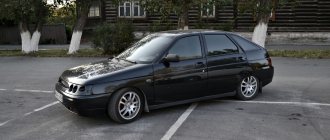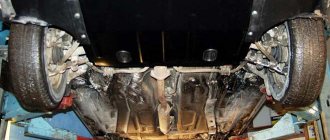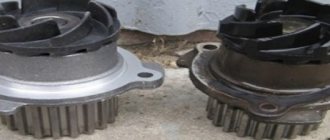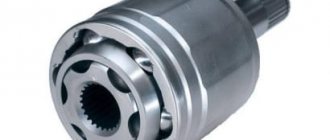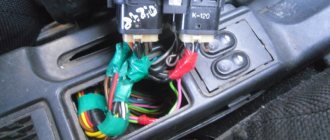JSC AvtoVAZ, in the process of producing cars of the tenth family, was constantly improving their power units. And engine 21124 is no exception.
Created on the basis of the 2112 engine in 2004, this engine differed favorably from other engines in this series due to its high environmental characteristics and increased cylinder capacity.
Later it became the prototype of more powerful VAZ power units:
- 21126, which has been installed on the VAZ 2170 Priora since 2007;
- 21128 with a volume of 1.8 liters, mass-produced at the Super-auto enterprise and intended for installation on LADA 112 Coupe, LADA Priora, etc.
Car history
In 1983, the design of a sedan on the platform of the VAZ-2108 hatchback began.
The project was named VAZ-2110. But it's interesting that the design team made too many changes that made the car more expensive. Because of this, in 1984, this project was separated from the project of a simple “transition” of the VAZ-2108 into a sedan (which later received the name VAZ-21099). The first experimental version of the “ten” was released in July 1985. The management had plans to put the car into mass production since 1992, but the ensuing economic crisis had an impact. The debut versions of the “ten” were released in June 1995. AvtoVAZ was directly involved in production.
VAZ-2110 Experienced
Serial production of the cars began in August 1996, and the new product could be purchased already in the same year. In those years, global automotive technology rose to a new level and a breakthrough car until the end of the 1980s could not be called a completely new vehicle. But despite these and other complaints about build quality in the 1990s, the car was a clear step forward for the Soviet automobile industry.
If we compare the Zhiguli and Samara, the 2110 was positioned as a higher-class car that was modern and competitive both externally and internally. To be more precise, the VAZ-2112 has an electronic powertrain control system (although the debut versions came with carburetors) and a diagnostic unit (on-board computer).
In addition, it was possible to install a hydraulic power steering wheel and electric windows on the Lada 2112. Body parts were made of galvanized metal, new body painting technology was used, and so on. Issue 2110 marked a new stage in the development of the Soviet automobile industry. The hero of our article, Lada 2112, appeared a little later, in 1999, almost immediately after the VAZ 2111 station wagon. Today we will get to know this domestic model better.
Cylinder head (cylinder head)
It is cast from aluminum and performs the functions of injecting fuel into the cylinders and removing combustion products. Inside there are channels for pumping oil and coolant, which enter through several holes at the junction with the cylinder block.
The casting is completed with the following parts: valves, their guides and springs, hydraulic compensators, 2 camshafts (inlet and outlet) and their bearings. At the ends of the shafts on one side there are gears with a diameter 2 times larger than the crankshaft. On the other is a phase sensor operating on the Hall effect.
The main innovation in the cylinder head 21124 compared to eight-valve engines (2111 and 21083) is the automatic adjustment of the gaps between the valves and the camshaft cams. This was achieved by adding hydraulic compensators to the cylinder head design.
Features of the VAZ 2112
A special feature of this car was its body, made in the form of a hatchback, which was not quite familiar to domestic cars at that time. At the same time, the creators decided to give the new car some sportiness. In addition to the body shape, which excluded the rather awkward rear part of the VAZ 2110, this feature was realized by changing the proportions between the main coordinate axes of the car.
Photo of the updated VAZ 2112
Photo Lada 2112 - side view
As a result of some shortening of the length, the car acquired visible lightness and swiftness. This impression was further enhanced by the ground clearance of 16.5 cm. Among other things, its handling has improved. He began to listen more sensitively to the steering wheel.
- At the same time, the capacity of its trunk in the standard version was 400 liters, but the ability to increase its volume due to the folding backrests of the rear row seats made the car more convenient for transporting goods, while it became possible to remove only one half of it, which ensured the versatility of using this functions.
- The curb weight of the car with a 43-liter gas tank completely filled with gasoline was just over one and a half tons.
Official photo of VAZ 2112
Photo Lada 2112 - rear view
Production of the Lada 2112 in various modifications lasted 8 years , which, in principle, for modern not only domestic, but also global automotive industry, is quite a significant period of time, confirming the success of the car’s design. The “twelfth” was displaced from the assembly lines by the gaining strength and popularity of the Lada Priora 2014.
Reliability
The reliability of the VAZ-21124 internal combustion engine is indicated by the fact that it exceeds the mileage life established by the manufacturer. There are engines that have gone through more than 300 thousand km without major repairs. This is clearly visible from the communications of forum members. Thus, Maxim writes: “... an engine with a long service life. Mileage 330 thousand. Doesn't take oil. Replace the timing belt according to the regulations, every 45-50 thousand km, pump every 100 thousand. The oil was 5-40 synthetic.”
The manufacturer constantly makes changes to the design of the motor in order to increase its reliability. There has been a decrease in electrical failures (due to the abandonment of high-voltage wires, the installation of individual coils and other innovations).
Two more important reliability criteria - “stickless” pistons
Technical characteristics of VAZ 2112 (Lada)
- At the beginning of its life, the Lada 2112 was produced with a 1.5 liter 4-cylinder engine with 16 valves in the gas distribution system. The “zero” version received another official name GLI luxury. This was considered a forced performance of the engine, since there was a model with an 8-valve engine. In the documentation it was designated as VAZ 21122. Without power windows, with non-ventilated disc brakes taken from the “ancient” V8 and with a simplified interior design, it became a budget version of the car.
- After 4 years, 1.5-liter engines were completely replaced by 1.6-liter injection engines. The VAZ 21124 model is rightfully considered the most advanced version of the 12th generation. An injector with 2 upper shafts of the gas distribution system produced a power of 89 hp and a torque of 131 Nm. A car with such an engine accelerated in 12.5 seconds. up to hundreds of kilometers and on a good road it could steadily maintain a maximum speed of 185 km/h. Fuel consumption, which could be high-octane gasoline AI-95, in mixed driving mode was around 7.7 liters per 100 km.
Photo VAZ 2112
Photo of blue Lada 2112
Photo of yellow Lada 2112
However, at first everything was not so rosy. The first buyers of this modification of the car were faced with a characteristic, often recurring breakdown - bending of the valves. VAZ designers quickly found the cause and an inexpensive but effective way to eliminate it. The bottom of each piston in the cylinders has a deeper groove. Subsequently, there were no consumer complaints about the modified engine.
Technical characteristics of VAZ 2112
Modifications
LADA 21120 (VAZ-21120): 16-valve 1.5-liter engine 21120 standard version and GLI luxury version. LADA 21121 (VAZ-21121): 8-valve 1.6-liter engine 21114. LADA 21122 (VAZ-21122): 8-valve 1.5-liter engine 2111. Budget version on R13 wheels, non-ventilated brakes from VAZ 2108 and without power windows. LADA 21124 (VAZ-21124): 16-valve 1.6-liter engine 21124. Produced from 2004 to 2008. In this modification of the 2112 engine, the problem with valve bending was solved by increasing the depth of the grooves in the piston heads (up to 6.5 mm). In addition, the design of the cylinder block was changed to achieve a displacement of 1.6 liters. To achieve this, its height was increased by 2.3 mm, and the radius of the crankshaft crank was increased by 2.3 mm. LADA 21128 (VAZ-21128): 16-valve 1.8-liter engine with 98 hp. and 123 hp This is a luxury version of the car from Super-auto JSC.
Performance characteristics of the VAZ 2112 twelfth hatchback
Maximum speed: 185 km/h Acceleration time to 100 km/h: 12.5 sec Fuel consumption per 100 km in the city: 9.4 l Fuel consumption per 100 km on the highway: 5.9 l Fuel consumption per 100 km in the combined cycle: 7.4 l Fuel tank volume: 43 l Vehicle curb weight: 1060 kg Permissible gross weight: 1515 kg Tire size: 175/65 R14
Engine characteristics
Location: front, transverse Engine capacity: 1597 cm3 Engine power: 90 hp Number of revolutions: 5000 Torque: 131/3700 N*m Power system: Distributed injection (multipoint) Turbocharging: no Gas distribution mechanism: DOHC Cylinder arrangement: In-line Number of cylinders: 4 Cylinder diameter: 82 mm Piston stroke: 75.6 mm Compression ratio: 10.3 Number of valves per cylinder: 4 Recommended fuel: AI-95
Brake system
Front brakes: Disc Rear brakes: Drum
Steering
Steering Type: Rack and Pinion Power Steering: No
Transmission
Drive: Front Number of gears: manual – 5
Suspension
Front suspension: independent, spring Rear suspension: semi-independent, spring
Body
Body type: hatchback Number of doors: 5 Number of seats: 5 Vehicle length: 4170 mm Vehicle width: 1680 mm Vehicle height 1420 mm Wheelbase: 2489 mm Front track: 1400 mm Rear track: 1370 mm Ground clearance (clearance): 171 mm Trunk volume: 400 l
Production
Year of manufacture: from 1999 to 2008
Performance characteristics of the VAZ 2112 twelfth hatchback
Maximum speed:
185 km/h
Acceleration time to 100 km/h:
12.5 sec
Fuel consumption per 100 km in the city:
9.4 l
Fuel consumption per 100 km on the highway:
5.9 l
Fuel consumption per 100 km in the combined cycle:
7.4 l
Fuel tank volume:
43 l
Curb weight of the vehicle :
1060 kg
Permissible gross weight:
1515 kg
Tire size:
175/65 R14
Engine characteristics
Location:
front, transverse
Engine capacity:
1597 cm3
Engine power:
90 hp
Number of revolutions:
5000
Torque:
131/3700 N*m
Power system:
Distributed injection (multipoint)
Turbocharging:
no
Gas distribution mechanism:
DOHC
Cylinder arrangement:
In-line
Number of cylinders:
4
Cylinder diameter:
82 mm
Piston stroke:
75.6 mm
Compression ratio:
10.3
Number of valves per cylinder:
4
Recommended fuel:
AI-95
Brake system
Front brakes:
Disc
Rear Brakes:
Drum
Steering
Steering type:
Rack and pinion
Power steering:
no
Transmission
Drive unit:
Front
Number of gears:
manual transmission – 5
Description
The VAZ 21124 engine is part of the line of 16-valve power units produced by AvtoVAZ JSC. It is an in-line 4-cylinder power unit with overhead camshafts and electronic fuel injection (injector).
The gas distribution mechanism is driven by a belt, which must be changed every 45,000 km. At the same time, the manufacturer recommends inspecting it for damage and eliminating sagging every 15 thousand km of the distance traveled.
Modifications of VAZ 2112 (Lada)
Particularly worth noting are the latest versions of the “twelfth” - VAZ 21123 and VAZ 21128. They have not become widespread, but are of some interest to automotive enthusiasts.
- “Troika” was remembered, as they say now, for its facelift and at the same time received a loud designation - “ Lada 112 Coupe ”. It was a 3-door hatchback, further distinguished from previous production models by the modified shape of the hood and front bumper. There was one more change that was not noticeable to the naked eye. The designers increased the rigidity of the car's structure. Its owners noted a slightly different behavior of the car when accelerating. But the attractive word “coupe” actually did not mean anything other than a more luxurious interior trim. In this way, an additional marketing ploy was carried out.
- The VAZ 21128 was produced in even smaller quantities than the previous model. In the engine compartment of the car, the steel heart of a 1.8 liter 16-valve semi-experimental engine beat powerfully. It was with him that VAZ reached the milestone of 100 hp. However, it is worth noting that Volzhsky Auto itself was not its manufacturer.
Photo of a tuned Lada 2112
Photo of the new VAZ 2112
For the entire series of 12 models, it was the VAZ 21128, thanks to its power characteristics, that could rightfully claim the title of supercar.
VAZ 2112 (Lada) configurations:
| Modification | Year of issue | Engine | Acceleration to 100 km/h | Average consumption per 100 km |
| 2112 MT | 2000-2004 | 92 hp | 12.5 s. | 7.2 l |
| 21121 MT | 2004-2009 | 80 hp | 13.5 s. | 7.2 l |
| 21122 MT | 2004-2009 | 78 hp | 14.0 s. | 7.2 l |
| 21123 MT (coupe) | 2007-2009 | 80 hp | 13.5 s. | 7.5 l |
| 21124 MT | 2004-2009 | 91 hp | 12.5 s. | 7.2 l |
Consumer Reviews
Technical specifications are, of course, good, but before buying, read what the owners of this car write. There is a lot of talk about both positive and negative traits. In particular, it is said that the level of comfort could be improved. Some nodes are extremely unreliable. In particular, we are talking about a battery that does not survive even one winter. True, in this case a lot depends on its proper storage. Consumers often note that the car does not start in severe frosts. But this is inherent in all VAZ cars, so there is no need to worry too much about this. You will not experience such problems if the vehicle is stored in a heated box. This car was produced for only a few years, so many have never even heard of it. The successor of the VAZ-21128 from. Well, that’s all about the VAZ-21124 car. We have looked at the characteristics of the car, its design, ergonomics and performance qualities.
Development of the model range
AvtoVAZ designers began to think about developing a sedan based on the VAZ 2108, 2109 series in the mid-80s. It was the development of this that led to the design split in Tolyatti, the consequences of which are still felt today. Instead of simply changing the contours of the rear part of the VAZ 2109 body and making a spacious trunk, the designers proposed almost a thousand different changes, including quite expensive ones. An electronic engine control and diagnostic system (on-board computer), a new galvanizing technology, power steering, etc. were provided. AvtoVAZ management, instead of closing the expensive project, decided to carry out work in two directions:
- complicated development of VAZ 2110;
- creation of a simplified version of the VAZ 21099.
Subsequently, both concepts coexisted in the design bureau and on the factory assembly line. The VAZ 2110 line developed into the 110 family and later into the Lada Priora, and the VAZ 21099 line became the basis of the Samara 2, Kalina and Kalina 2 family.
This development of the line has led to the fact that the plant’s assembly line currently produces series of cars with very similar technical characteristics, with weakly expressed sectoral market preferences.
Generations 2112
1995
2112
2000
21120
2000
21122
2004
21121
2004
21124
Engine tuning 21124
There is no point in considering chip tuning of a 124 engine, it will not make any noticeable changes on a standard car, the firmware is needed for more thorough and correct tuning, after the engine has been modified, we will start with it. The simplest and most standard way to increase the power of the 21124 engine is to replace the camshafts with Stolnikov 8.9 280 or Nuzhdin 8.85, install a 4-2-1 direct-flow exhaust, a receiver and a 54-56 mm damper, this will give us a total of more than 120 hp, and for more efficient operation of the motor, we replace the piston with a lightweight Prior one. This will further increase power and reduce fuel consumption. In cases where these numbers are not enough, it is recommended to modify the cylinder head and install wide-phase shafts, which will give an output of 150+ hp.
Compressor for VAZ 21124 16V
As an alternative, and also to obtain similar power over the entire range, you need to install a compressor. The most common compressor for VAZ is the St. Petersburg kit based on the PC-23, but the Internet is full of videos on compressors both on the 8 valve and on the shesnar, in one of the most famous videos, the owner of the motor on the compressor clearly explains all the nuances of installation and what is required for the successful implementation of the project using the example of an eight-valve engine. This compressor can also be installed on a 16 valve engine.
Attention MAT (18+)
It is possible to increase power without using a turbine up to 200+ hp, using a 4-throttle intake, but the most optimal options suitable for urban use are the methods described above.
4 throttle intake for VAZ 21124
To increase the stability of the engine and the response of the gas pedal, install 4 throttles. The bottom line is that each cylinder receives its own throttle valve and, thanks to this, resonant air vibrations between the cylinders disappear. We have more stable engine operation from bottom to top. The most popular method is to install a 4-throttle intake from Toyota Levin on a VAZ. You need to purchase: the unit itself, make an adapter manifold and pipes, in addition to this you need a nulevik filter, injectors, MAP (absolute pressure sensor), fuel pressure regulator and firmware. There are also ready-made 4-throttle intake kits on sale that are quite suitable for use. Considering the prohibitive speeds, it is recommended to replace the heavy piston 124 engine with a lightweight Priora one, wide-phase shafts (at least 280), a modified cylinder head, a 4-2-1 spider exhaust with 51 pipes or more. For more complete information on throttles, see the article on tuning the 2112 engine. With the correct configuration, the 124 engine produces about 180-200 hp. The disadvantages include a reduction in engine life, and this is not surprising, because the engines on the pipes spin at more than 8000-9000 or more rpm. So you cannot avoid constant breakdowns and repairs.
Pros and cons of the twelfth model
The duality of the design concept led to the fact that the Lada 12 was never the only five-door hatchback in the production program of the Tolyatti plant. The AvtoVAZ hatchback VAZ 2112 rolled off the assembly line from 1999 to 2008. It shared its place on the assembly line with other five-door cars in the same body:
- from 1999 to 2001, Lada 12 and VAZ 2109 were produced in parallel;
- from 2001 to 2004, VAZ 2112, VAZ 2109 and VAZ 2114 were released simultaneously;
- from 2004 to 2008, model 12 was produced in parallel with the VAZ 2114.
The features of the target audience of the 12th fret are very poorly read, in contrast to alternative models. Buyers of the VAZ 2109 represented a large army of staunch supporters of the most popular domestic car of the 90s - the “nine”, glorified in songs. The fourteenth model that appeared later also had many fans. A light face lift only benefited the car. New headlights and the design of the front end refreshed the appearance of the car; it became noticeably more modern, which the market liked.
The Lada 12 had little to offer in this competitive competition. The electronic fuel injection engine control system offered few advantages because the first twelfth models entered the market with a carburetor version of the engine. When injection versions of the Lada 12 appeared, competitors were not slow to repeat this move. All that remained was a more than dubious attempt to follow the ideas of biodesign that was fashionable at that time. Such tuning of the VAZ 112 did not give serious success, because:
- the ideas themselves were 15 years out of date by the time the car appeared;
- they were implemented very clumsily.
In terms of technical parameters, models 2112 and 2114 are very similar. VAZ 2112 is 4 centimeters longer than its brother in the production line. For comparing cars of the same layout, the volume of a cube is great, into which you can fit a car with specific dimensions. This parameter is in the case of model 2114 4122 mm x 1650 mm x 1402 mm = 3817 cubic meters. dm. And for 2112 - 4170 mm x 1680 mm x 1435 mm = 4050 cubic meters. dm. The difference is 5.7%. In terms of total weight, the cars (1410 and 1495 kg, respectively) differ by 5.6%.
But the trunk of the VAZ 2114 is significantly smaller - 330 liters versus 399. Additionally, in Lada 12 you can free up another 330 liters for luggage by folding the rear seats. You can fold them partially - the back is divided in a ratio of 1:2, and the parts fold independently of each other. Car owners note that the interior of the twelfth model is cramped for passengers taller than 180 cm. Common to both cars, car enthusiasts note shortcomings in the operation of the heating system, shortcomings in seat adjustments, as well as a creaky interior.
The direct descendants of the 2112 and 2114 models, the Lada Priora and Lada Kalina 2 hatchbacks, differ little from each other and are sold in the same market sectors as their predecessors.
Chassis and its advantages
On the move, the “two-piece” is akin to a foreign car of those times: soft, smoothly overcoming bumps. The whole feeling is spoiled by the front panel bouncing on the pits.
The clearance of the VAZ-2112 is high even by today's standards. 160 cm along with short overhangs allow you to easily climb curbs and easily drive through large holes without touching the bottom. When fully loaded, due to the design, the rear wheels begin to “shuffle” against the arches.
Disadvantages of VAZ-2112
Most used Twelves are sold with corrosion. It covers the rear fenders, the spare wheel well, the sills, the bottom, and the contour of the windshield rubber seal. If the car has not been looked after, there may be corrosion at the bottom of the doors.
Replacement will cost a decent amount: doors excluding painting - about 9,000 rubles apiece, rear fenders - about 6,000 rubles, a niche for a spare wheel - 1,500 rubles. For painting one element you will have to pay at least 5,000 rubles per element. Even at the slightest hint of rust, run away from the car. It’s better to take a closer look at the well-painted version: it has no corrosion - you won’t have to spend money on repairs.
When buying a 16-valve engine, set aside 6,000 rubles to replace hydraulic compensators (they last no more than 100 thousand km, and if the oil quality is poor, even less), on many cars they knock. The mass air flow sensor often fails. The first signs by which you will know about a breakdown will be increased fuel consumption and high idle speed (replacement - from three thousand rubles).
Also pay attention to the front struts and their supports. The former often fail after 30 thousand kilometers, while the latter’s tires begin to peel off (all together will cost from 6,000 rubles).
Another common problem with the VAZ-2112 is non-working rear lights. You will have to either change the board or clean and tighten the contacts. By the way, the rear lights of the “twelve” often fog up, and this, unfortunately, cannot be cured.
Malfunctions
VAZ 21124 engines have the same set of characteristic disadvantages characteristic of all VAZ engines. The most common:
| FAULTS | CAUSES | REMEDY METHODS |
| The engine is unstable or stalls at idle. | Ÿ Broken idle speed sensor. Air leaks through the crankcase ventilation hoses and the hose connecting the intake manifold and the vacuum brake booster. | Ÿ Change the idle speed sensor; replace damaged hoses; Ÿ tighten the hose clamps. If this does not help, check the serviceability of the fuel injection system. |
| The motor does not develop full power. | Ÿ The throttle valve does not open fully. Ÿ Broken throttle sensor. Ÿ The air filter is clogged. Poor quality fuel. | Ÿ Adjust the throttle valve drive; Ÿ change the faulty sensor; Ÿ change the air filter. |
| Increased fuel consumption. | Ÿ Ÿ Fuel leaks in connections. Ÿ Broken injectors and/or ignition system. Increased resistance to vehicle movement. | Ÿ Fill with high-quality fuel; Ÿ check and, if necessary, tighten the fastening clamps. Replace damaged parts; check the operation of the engine control system and fuel injection; Ÿ check the alignment of the front wheels, the operation of the brake system and the tire pressure. |
Opinion of car enthusiasts
Owner reviews of the VAZ 2112 are mostly positive. Despite many shortcomings, poor build quality and components, this car is highly popular among the younger generation in Russia and some CIS countries.
The reasons for such a loyal attitude towards the car can be considered its attractive body design, as well as high-torque engines.
Cylinder block and connecting rod-piston group (SHPG)
This is the main part of the engine in which the energy of burned fuel is converted into mechanical energy. It consists of a cylinder block, pistons, connecting rods, connecting pins of support bearings, a crankshaft and half rings that limit the displacement of the latter relative to its axis.
The VAZ 21124 engine with 16 valves is equipped with a “high” block 11193, which received its nickname due to its size. It is cast from cast iron, and then it is machined to accommodate the cylinders. Its height is 197 millimeters (from the axis of rotation of the crankshaft to the top edge). It is 2.2 mm higher than the cylinder block used in the 21120 engine. This increase allowed the displacement to be increased to 1.6 liters without increasing the cylinder diameter. The block is also distinguished by a reduced size of the holes for the cylinder head mounting bolts.
The crankshaft (catalog number - 11183 -1005016), like the block, is cast from cast iron. The journals (points of contact with other parts) are polished and holes are drilled in them to lubricate the support and connecting rod bearings. To reduce vibration from rotation, 8 counterweights are installed on the shaft, shaped like half a disk.
The connecting rods are forged from steel and consist of two heads - upper and lower. At the top there is a bushing made of steel-bronze alloy for attaching the piston. Liners (sliding bearings) are pressed into the lower one. The connecting rod is attached to the crankshaft using a cover and 2 bolts.
Price policy
| Auto | Cost (rubles) |
| VAZ 2112 | from 80 to 200 thousand |
Options and prices
Today, you can purchase a used domestic VAZ-2112 model in well-maintained condition from 150,000 rubles. There's not much to say about the packaging. The car has hydraulic power steering and a heater, which increases the level of comfort. Security is low.
General information about the machine
At the very beginning I would like to tell you a little about the car’s appearance and interior trim. In principle, you can’t count on anything supernatural, since the car can be classified as a budget class car. In the basic configuration, the vehicle's windows are not tinted, but the exterior is an order of magnitude better quality than that of the same Nexia.
At the same time, we can safely say that the driving performance is at the same level. The car is very dynamic, accelerates quickly and stays confidently on the road. Depending on your driving style and road condition, you will not experience any discomfort for the first 10-20 thousand kilometers. In the future, squeaks and looseness of the suspension may appear. But all this can be eliminated quite quickly if there is a desire and time.
Weak spots
Unfortunately, the updated engine still has old weak points. Traditionally, the electrician is lame. Failures in the operation of sensors (DPKV, MAF, DPS) cause unstable (floating) idle speed. Additionally, the cause of this phenomenon may be an excessively dirty throttle valve or a malfunction in the idle air regulator.
Troubling at idle speed is not uncommon. Here the cause must be sought in faulty ignition coils or spark plugs. It must be remembered that tripping can be caused by burnt-out valves.
Extraneous unauthorized knocks are inherent in internal combustion engines. Most often they indicate wear of the hydraulic compensators. Less often - for wear of the CPG.
Weaknesses make themselves felt in cases of violation of the order and rules of engine maintenance. In any case, if any malfunction is detected, the engine urgently requires diagnostics at a specialized car service center.
